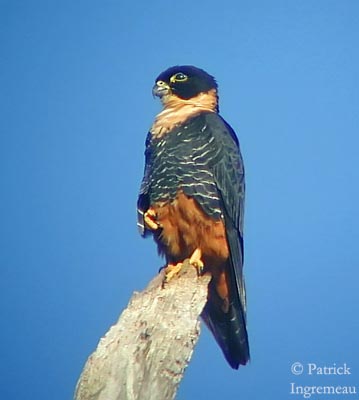
Bat Falcon
Falco rufigularis
Falconiforme Order – falconidae Family
BIOMETRICS:
Length: 24-29 cm
Wingspan: M: 58cm - F: 67cm
Weight: M: 110-140 g- F: 180-240 g
DESCRIPTION:
Bat Falcon has black head and upperparts. Feathers show greyish edges from upperback to tail coverts.
It has white chin, throat and upper breast, with rufous extension to the rear neck, and half white collar.
Lower breast is black, finely streaked with white.
Thighs, belly and vent are chestnut. Bat falcon has long black tail, finely streaked with white or grey, and buff tip.
PROTECTION / THREATS / STATUS:
Bat Falcon populations are stable in Argentina, but in Mexico and Central America, this species is endangered, with habitat loss and deforestation.
Fr: Faucon des chauves-souris
All : Fledermausfalke
Esp : Halcón murciélaguero
Ital : Falco golarossa
Nd : Vleermuisvalk
Photographers :
Marc Chrétien
MURINUS
Maxime Dechelle
LEPAPARRAZO
Patrick Ingremeau
TAMANDUA
Text by Nicole Bouglouan
Sources :
HANDBOOK OF THE BIRDS OF THE WORLD Vol 2 by Josep del Hoyo-Andrew Elliot-Jordi Sargatal - Lynx Edicions - ISBN: 8487334156
PORTRAITS D’OISEAUX GUYANAIS - Groupe d'étude et de protection des oiseaux en Guyane (GEPOG) - Ibis rouge éditions - ISBN: 2844501842
Animal Diversity Web (University of Michigan Museum of Zoology)

Eyes are dark brown with yellow eye ring. Bill is hooked, small and black, with yellow cere. Legs and long feet are yellow, with black claws.
Both sexes are similar, with female larger than male.
Immature resembles adults, with uniform black upperparts and buffer throat.
We find three subspecies, petoensis, rufigularis and ophryophanes.
They differ in tone of plumage coloration.
VOICE: SOUNDS BY XENO-CANTO
Bat Falcon calls to the female during breeding season. Its call is a high pitched “ke-ke-ke”.
HABITAT:
Bat Falcon inhabits at the edge of tropical rain forest and woodlands in semi-arid areas. It prefers unbroken forests where it may forage over the canopy. It also lives in vegetation beside streams. It may occur from 900 to 2000 metres of elevation.
RANGE:
Bat Falcon lives in Mexico and Central and South America, from Mexico to northern Argentina.
BEHAVIOUR:
Bat Falcon is often perched on exposed branches of dead trees. It is a solitary bird, spending most of its time hunting, dropping down to the prey to catch it, or performing aerial attack.


It feeds on bats, but not only, generally snatched at dawn or dusk, when they come in or out from their roosts. It may catch preys on the wing, with stunning agility, such as hummingbirds, swallows and swifts. It also catches preys on the ground, such as rats and geckos.

From high perch, it attacks the birds flying above the canopy, or in open areas. It flies low over the canopy and flushes preys from the vegetation by disturbing them while it claps the wings and then, flying up to catch insects leaving the tree.
Bat Falcon hunts mostly at dusk and dawn, and it is nocturnal.
During the breeding season, the male offers preys to its mate before copulation.
Both parents defend strongly the nest, chasing other raptors.
FLIGHT:
Bat Falcon has direct and powerful flight. It can pursue its prey very swiftly. It may perform acrobatic flights to catch a prey on the wing. It flies quickly with strong and shallow wing beats. It often flies above canopy.
REPRODUCTION:
Bat Falcon’s nest is often located in tree cavities or abandoned holes from woodpeckers, or old parrots’ nests in termite colonies. It also can be found in cliffs, ruins, with open access, very high in trees, between 10 and 50 metres above the ground.
Female lays 2 to 4 white eggs, spotted with brown. Incubation lasts about 4 to 7 weeks. The male brings food at nest until the young fledge, about 35 to 40 days after hatching. They are fully feathered and they are able to eat preys on their own.
During this period, both adults protect young and nest, chasing away from the nest all raptors, sometimes on one kilometre of distance.
DIET:
Bat Falcon feeds on bats, of course, but mainly on small birds and large insects such as dragonflies, moths and large grasshoppers.
Its diet varies by summer and winter. In summer, it feeds on birds, and in winter it takes insects. It may eat some lizards and mice.
